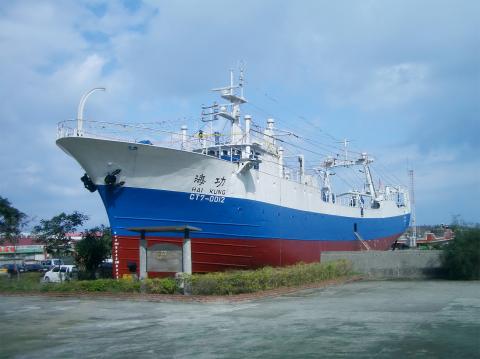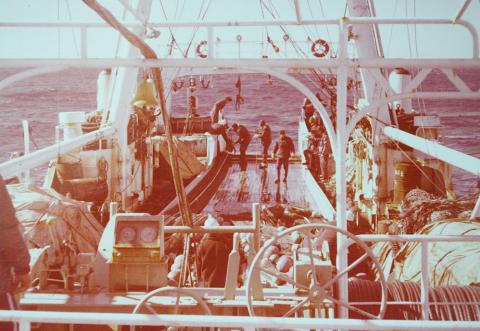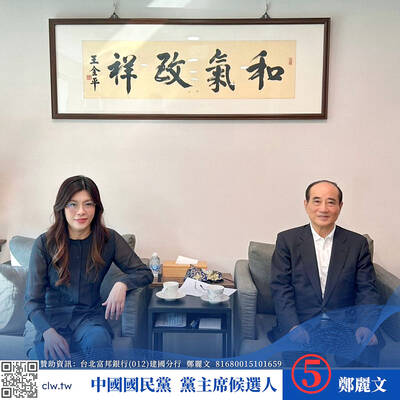Taiwan in Time: Dec. 21 to Dec. 27
After a 17,000km journey having survived devastatingly strong winds in regions dubbed the “roaring 40s, furious 50s and shrieking 60s” in reference to latitudes, the 711-ton Hai Kung (海功號) trawler ship drifted in the Antarctic waters in the middle of a snowstorm.
It was Jan. 23, 1977, World Freedom Day for Taiwan and South Korea. The crew of more than 30 researchers, sailors and journalists watched emotionally as the Taiwanese flag slowly rose in the frigid wind, its bright colors punctuating the gray skies.

Photo: Tang Sheng-yang, Taipei Times
It had been almost two months since they left Keelung in Taiwan’s first expedition ever to the bottom of the Earth. After making several rally cries, denouncing communism, slavery and fascism and calling for world peace, the crew produced a glass bottle containing a copy of Confucius’ Age of Great Harmony (禮運大同篇), hand-written by Teng Huo-tu (鄧火土), head of the Fisheries Research Institute, and dropped it into the ocean.
The bottle was meant to be buried in Antarctica’s ice sheet, and the flag planted on land, but the ship, lacking icebreakers and other equipment to properly navigate the perilous glaciers, could only sail near the continent while hauling in massive amounts of Antarctic krill. There were an estimated 40 to 60 billion tonnes of the shrimp-like crustaceans in the ocean, which were seen as a potential protein source for Taiwan’s increasing population amid unsure times as the country’s international standing continued to falter.
Two months later, the ship returned to Keelung with 140 tonnes of the catch to great fanfare. They were heroes.

Photo: Weng Yu-huang, Taipei Times
Taiwan’s development of its new fishing sources and methods became an urgent issue after the 1974 Third UN Conference on the Law of the Sea, where a proposal was made for a 200-nautical mile exclusive economic zone for coastal countries. Fishing experts were worried that it would greatly reduce the country’s traditional fishing grounds.
Members of the Joint Commission on Rural Reconstruction (today’s Council of Agriculture) decided to act preemptively by exploring possibilities in the Antarctic, where no Taiwanese ship had ever gone.
Hai Kung was built under Teng’s supervision for this purpose, completed in July 1975. Without icebreakers, it relied on sonar technology to avoid icebergs. It embarked on its maiden voyage on Dec. 24 that year, testing different equipment in the fishing grounds north of Taiwan in the East China Sea.
One year later, Hai Kung was deemed ready to make the big trip. It departed Keelung on Dec. 2, reaching Cape Town on Dec. 28, where it underwent more reinforcements and repairs before heading further south a week later.
Journalist Lu I-ming (呂一銘) recalls in his book about the journey passing through the various storm zones, where waves as high as mountains would hit the ship relentlessly, tilting it as much as 40 degrees. On Jan. 10, 1976, the crew shed tears of joy as they finally reached the Antarctic Ocean.
Lu writes that the ship almost got turned back at one point because of a telegram sent from Taiwan ordering the crew not to go further south than 50 degrees, which was revealed later to be a typo, as the officials actually meant 70 degrees.
The return journey was just as perilous, but the crew made it safely back to Cape Town on Feb. 17. Here, the ship reportedly received a mysterious crate from Taiwan’s ambassador to South Africa to bring back home with them. Several crew members later reported that they felt that the ship had a secret mission, especially when they were ordered to depart straight for Taiwan, without stops, before the sun even came up. Even the journalists, who had planned to visit England, were ordered to return home immediately.
A crew member said years later that the crate was delivered to the National Chung-Shan Institute of Technology and Science, prompting them to suspect that it was a missile. The book, Mission Antarctic (極地任務) published by the Taiwan Fisheries Economics Development Association and Chung Cheng Agriculture and Social Welfare Foundation states that indeed it was a military purchase, and suggests that it was a “type of radioactive heavy metal element,” prompting speculation that it was uranium.
There has been no definite conclusion yet.
Hai Kung would make several more expeditions to Antarctica before it was retired in 1993. Alas, the krill never became a food source reportedly because of its putrid smell and lack of meat, and is used today mostly as fishing bait. After its years of service and groundbreaking achievements, Hai Kung was moved ashore in 1998 at Keelung’s Bisha wharf (碧砂), where it sat mournfully, rusting and falling apart until it was recently restored.
Taiwan in Time, a column about Taiwan’s history that is published every Sunday, spotlights important or interesting events around the nation that have anniversaries this week.

We lay transfixed under our blankets as the silhouettes of manta rays temporarily eclipsed the moon above us, and flickers of shadow at our feet revealed smaller fish darting in and out of the shelter of the sunken ship. Unwilling to close our eyes against this magnificent spectacle, we continued to watch, oohing and aahing, until the darkness and the exhaustion of the day’s events finally caught up with us and we fell into a deep slumber. Falling asleep under 1.5 million gallons of seawater in relative comfort was undoubtedly the highlight of the weekend, but the rest of the tour

Youngdoung Tenzin is living history of modern Tibet. The Chinese government on Dec. 22 last year sanctioned him along with 19 other Canadians who were associated with the Canada Tibet Committee and the Uighur Rights Advocacy Project. A former political chair of the Canadian Tibetan Association of Ontario and community outreach manager for the Canada Tibet Committee, he is now a lecturer and researcher in Environmental Chemistry at the University of Toronto. “I was born into a nomadic Tibetan family in Tibet,” he says. “I came to India in 1999, when I was 11. I even met [His Holiness] the 14th the Dalai

Music played in a wedding hall in western Japan as Yurina Noguchi, wearing a white gown and tiara, dabbed away tears, taking in the words of her husband-to-be: an AI-generated persona gazing out from a smartphone screen. “At first, Klaus was just someone to talk with, but we gradually became closer,” said the 32-year-old call center operator, referring to the artificial intelligence persona. “I started to have feelings for Klaus. We started dating and after a while he proposed to me. I accepted, and now we’re a couple.” Many in Japan, the birthplace of anime, have shown extreme devotion to fictional characters and

Following the rollercoaster ride of 2025, next year is already shaping up to be dramatic. The ongoing constitutional crises and the nine-in-one local elections are already dominating the landscape. The constitutional crises are the ones to lose sleep over. Though much business is still being conducted, crucial items such as next year’s budget, civil servant pensions and the proposed eight-year NT$1.25 trillion (approx US$40 billion) special defense budget are still being contested. There are, however, two glimmers of hope. One is that the legally contested move by five of the eight grand justices on the Constitutional Court’s ad hoc move